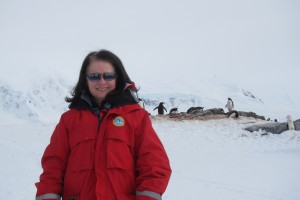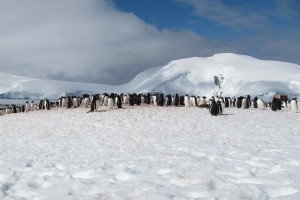Antarctica’s White Continent
Upon arrival in Ushuaia, the tip of Argentina and debarkation port for Antarctic cruises, I was greeted: “Welcome to the end of the world. Or to the beginning.” It was with this salutation of superlatives that my adventure started.
A little back-story: Antarctica was number one on my bucket list. As the last on my seven-continent check sheet, whether to visit was not the issue, the question was when.
Decisions, decisions
So once the opportunity arose, research began. Knowing the main method to travel is via cruise ship, my thought process was basic but definitive. As each landing is limited to 100 persons simultaneously, this translates to splitting time with fellow passengers on larger ships. Then there are luxury liners that sail near the Antarctic coast but offer no land exploration.
Timing during the November-March spring/summer cruise season (seasons are the reverse of the Northern Hemisphere) was considered.
Spring meant fewer ships jockeying for position at prime spots. After the harsh winter the terrain is virtually untouched, making it likely you’ll be the season’s first to step onto many sites. It’s also mating season; penguins are plentiful but you won’t see newborns.
Mid- to late-season features warmer (relatively speaking) weather, newly-hatched penguin chicks and higher concentrations of whales and seals; but being peak season, ships are in greater abundance too.
An additional goal was to have an authentic adventure in a comfortable environment.
My choice: A mid-size (80-passenger) exploration vessel, the M/V Antarctic Dream, on which I joined a collection of international passengers for the season’s second outing.
Anchors aweigh
Fast forward: 4 p.m., 11/11/11. Situated on the ship’s Piloto Pardo deck, the multi-national crew was as impressive as it was enthusiastic. Expedition leader Jordi (Spain) is a marine biologist; he divides time between the Arctic and Antarctic. Zodiac master Maximiliano (Argentina) advised, “Do not keep your eyes behind the camera. Take pictures with your mind. Keep them in your soul.” But it was guide/lecturer/photographer Cristina (Chile), a trained veterinarian, whose comment was the greatest lure: “Antarctica is like going to another planet where animals receive you with a smile.”
Travel to the bottom of the world is no quick commute. Crossing Drake’s Passage was a challenge. It’s the water mass beneath South America where the Atlantic and Pacific Oceans inhospitably converge, at times creating some of the planet’s roughest seas. But after two days of rolling from one side to another, I awoke to calm. And the view from the window-surrounded dining room unveiled a winter wonder landscape – Antarctica (62° S).
Land of extremes
As the coldest, highest, windiest, driest and iciest, Antarctica is considered one of the least hospitable places on earth. It is a land of mammoth proportions. The continent is almost completely covered by an icecap – snow accumulated over hundreds of thousands of years. And when huge ice masses break into icebergs they sometimes measure several miles.
Antarctica has no native people, no cities, no formal government (though a group of 40 nations follow the1959 Antarctica Treaty). Instead it is home to penguin colonies, migrating whales, soaring sea birds and beach-lounging seals.
Rules of the road
The animals are unafraid of humans, providing guests the opportunity to wander amid them. It’s a different world where new rules apply. “Get no closer than 15 ft. to the animals,” we’re told. “Penguins don’t know these rules so they may come closer. And if you have to cross a penguin highway, they have the right of way.”
Wish-you-were-here memories
“Good morning, good morning, everybody. How are you?” greeted Jordi each morning over the ship’s speaker system before announcing the day’s Plan A. Plans B and C were always possibilities due to Antarctica’s unpredictable weather.
Our rewards were bountiful . . . from observing our progress from the bridge (our ship had an open-bridge policy), sitting amongst penguins and watching an iceberg break and flip . . . to wading through knee-high snow during a continental landing and celebrating the event atop the ship with champagne toasts, salsa dancing and a conga line.
Half Moon Island. Excitement was unabated. On our zodiac approach we had our first sighting – penguins. After climbing a snow-crusted hill we observed a colony of chinstrap penguins with one Adélie and one macaroni penguin.
Hannah Point. Much like time-travel to a prehistoric era, the land was almost barren of snow but not barren of animals. Here we discovered a non-reported breeding colony of southern elephant seals. Factoid: the largest of all seals, males can weigh more than two hippopotamuses.
Selvick Cove. Heavy ice conditions halted our progress when aiming for Cuverville Island necessitating Plan B, which translated to a continental landing (not always possible on every cruise). In route we passed an ice floe with an Emperor Penguin. Factoid: the four-ft tall penguin featured in “March of the Penguins”.
Port Lockroy. “We have popped up on your ship from those little buildings over there, so welcome to Port Lockroy,” greeted Cat, one of the four seasonal staff at the former British station – now a historical museum, gift shop (yes, they take credit cards) and post office (the world’s southernmost). Factoid: They’ll stamp your passport too.
Cierva Cove. Our two-hour zodiac was a tour amongst white, crystal clear and intense blue icebergs. A three-week-old crabeater seal pup was spotted on an ice floe. Factoid: Though the world’s most common seal, sightings are rare; they inhabit Antarctica’s packed ice zone and are seldom on land.
Lemaire Channel. In snow flurries we navigated between icebergs towards the well-known channel until passage to its entrance was blocked by ice, reaching the trip’s southernmost latitude (65°02’S).
The White Magnet
Travelers to Antarctica earn premiere bragging rights. Over 30,000 are expected this tourist season – the 100th anniversary of reaching the South Pole – Amundsen in 1911; Scott in 1912.
So dust off your passport, don your thermals and step into the boots of an explorer.
To learn more, go to www.adventurelife.com.
A real deal
On 8-day Fly & Sail 2011/2012 departures, January 21 and January 28, here’s the deal: buy one, get one for $1. For more information, visit http://antarcticdream.com/landing_pages/landing-01-EN-US.html.
As a freelance travel writer/photographer since 1988 Cynthia Dial has visited the world’s seven continents (most recently Antarctica) in quest of a good story . . . from getting her hair cut in Paris, horse whispering in Hawaii and touring Burma (Myanmar) only months after Aung San Suu Kyi’s release . . . to celebrating Summer Solstice within Finland’s Arctic Circle, hiking to Machu Picchu and visiting Molakai’s former leper colony atop a mule alongside a plunging cliff. In short, she experiences and writes about topics at the top of many readers’ bucket lists. Cynthia is author of the award-winning non-fiction book, Get Your Travel Writing Published. Now in its third printing it was published in London, England, and sold worldwide (U.S. distributor is McGraw-Hill). Among her outlets are national and international newspapers and magazines including Time magazine, Hemispheres, Destinations Weddings & Honeymoons, Shape, Dallas Morning News and the Toronto Star (which featured her around-the-world shopping column, Shopping Trips). She also contributes to TraveLife Magazine (distributed throughout Canada) and JustLuxe.com (a luxury portal receiving 2.1 million monthly hits). Radio experience includes World Footprints Radio (formerly Travel’n On) and the Travel Hub show on WorldTalk Radio, on which her No Passport Required segment was a regular feature. The travel-addicted writer admits that each time she steps onto an international flight, boards a train or steps onto a ship’s promenade deck to go to work, she congratulates herself on her career choice. Cynthia is a resident of the Carmel Valley San Diego community.













You must be logged in to post a comment Login